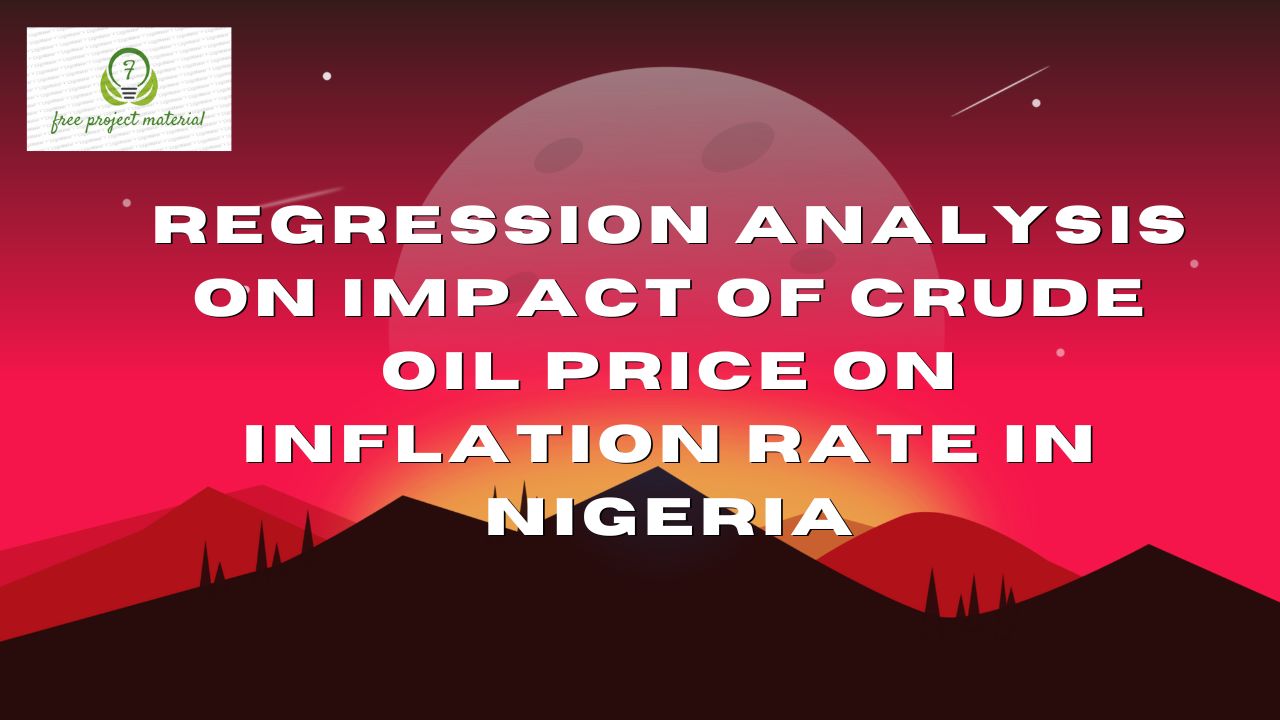ABSTRACT
This study examine the impact of crude oil price on inflation rate in Nigeria. The study made use of monthly data of Nigeria crude oil price and consumer price index from 2015-2019. The consumer price index was used as proxy for inflation rate i.e. inflation rate was measured by consumer price index (CPI). Correlation and regression analysis were the two major methods used in analyzing the data. The result of the correlation analysis revealed that there is a moderate positive relationship between crude oil price and CPI and this relationship was found to be significant (r=0.675; t-cal. > t-tab.). It was found from the fitted regression model that, consumer price index changes on the average by 2.447 per unit increase in the crude oil price. It was further found that, crude oil price account for 45.5% of the variation in CPI (R2 = 0.455). The study concluded that Nigeria crude oil price have a moderate relationship with inflation rate and the price have negative impact on inflation rate in the country because the increase in the price increase the inflation rate. Among others, it was recommended that, government should diversify the economy by developing other sectors and also ensure proper distribution of revenue generated from oil sector.
TABLE OF CONTENT
Title age – – – – – – – – – i
Certification – – – – – – – – ii
Dedication – – – – – – – – – iii
Acknowledgments – – – – – – – – iv
Abstract – – – – – – – – – v
Table of contents – – – – – – – – vi-viii
CHAPTER ONE: GENERAL INTRODUCTION
- Preliminary – – – – – – – – 1-3
- Statement of the Problem – – – – – – 3-4
- Objective of the Study – – – – – – 4
- Assumptions of the Study- – – – – – 5
- Statement of Hypothesis – – – – – – 5
- Significance of the Study – – – – – 5-6
- Scope of the Study – – – – – – 6-7
- Definition of Terms – – – – – – 7
CHAPTER TWO: REVIEW OF RELATED LITERATURE
2.1 Introduction – – – – – – – 8
2.2 Literature Review – – – – – – – 8-18
CHAPTER THREE: RESEARCH DESIGN AND METHODOLOGY
3.1 Introduction – – – – – – – 19
3.2 Design of the Study – – – – – – 19
3.3 Population of the Study – – – – – – 20
3.4 Sampling Procedure - – – – – – 20
3.5 The Sample – – – – – – – – 20
3.6 Data Collection – – – – – – – 20-21
3.7 Data Analysis Techniques and Presentation – – – 21-22
3.8 Data Preparation – – – – – – 22
CHAPTER FOUR: DATA ANALYSIS, RESULTS AND
INTERPRETATION
4.1 Introduction – – – – – – – – 23
4.2 Data Presentation – – – – – – 24-25
4.3 Data Analysis – – – – – – – 26
4.3.1 The Graphical Presentation of Data – – – – 26-27
4.3.2 Fitting of Regression of Model – – – – – 27-28
4.3.3 Correlation Analysis- – – – – – – 28-34
4.3.4 Hypothesis Testing- – – – – – – 34-35
4.4 Interpretation of Results – – – – – – 36-37
CHAPTER FIVE: SUMMARY AND CONCLUSION
5.1 Introduction – – – – – – – – 38
5.2 Discussion – – – – – – – – 38-40
5.3 Summary – – – – – – – – 40
5.4 Conclusion – – – – – – – – 41
5.5 Recommendation – – – – – – 41-42
References
CHAPTER ONE
INTRODUCTION
1.1 Preliminary
In the last seven decades, crude oil remain the world’s most important source of energy. Its products underpin modern society, mainly supplying energy to power industry, heat homes and provide fuel for vehicles and aeroplanes to carry goods and people all over the world (UK Oil & Gas, Economic Report 2015). Pharmaceutical companies are not left out of those who have discovered use of this, mineral oil and petrolatum are byproducts used in many body creams and topical pharmaceuticals. Other unexpected products containing or made from petroleum are toilet seats, crayons, ink, hair coloring, and lipsticks. With the highlighted great importance of petroleum, this has correspondingly leads to a high demand and subsequently an increased price cost, which makes a great source of income revenue for oil producing countries (Enitan, 2017). The importance of oil has risen to the extent that in a world suddenly without oil, all the major distribution system that induce economic transactions on a more than local basis would fall and the world economy would collapse (Gronwald, 2008).
Consequently, sudden disruptions in oil supplies and sharp increases in its prices are among the most important shocks hitting world economies. Oil has remained an important commodity that drives economic activities globally, and thus, oil price movements are a major determinant of macroeconomic outcome across countries.
In Africa continent, Nigeria is the largest oil producer, it holds the largest natural gas reserves on the continent, and was the world’s fourth-largest exporter of liquefied natural gas (LNG) in 2018 (BP, 2019). Nigeria’s crude oil and natural gas resources are the mainstay of the country’s economy. It is the major source of foreign exchange earnings and dominant source of revenue for Nigeria government, in which its high dependence serve as the basis upon which revenue distribution, budgeting, and capital allocations are determined in the country.
Crude oil production accounted for an average of one-fourth of its GDP from 1981 to 2018. Similarly, oil exports constituted about 95.7 percent of total exports, while oil revenues accounted for an average of 73.3 percent of government collected revenues during the same period (Sanni et al, 2020). Consequently, the country’s macroeconomic performance has been strongly associated with the oil sector. It is on this basis, this study is conducted to determine the impact of crude oil price on the country consumer price index.
1.2 Statement of the Problem
Oil price can have significance effect on determining the economic performance as oil is the main source used in productions of many goods. In particular, oil price changes may pass-through into production cost. Higher production cost may lead to higher consumer price. Therefore, excesses fluctuation in oil price may lead to volatility in domestic inflation which may later influence the economic stability and performance globally. Nevertheless, the extent to which changes in oil prices affect macroeconomic performance varies across countries, this is due to the fact that, various country level of dependence on crude oil differs. However, Nigeria is one of the country that highly depend on crude oil, thus it’s important to examine how the changes in the crude oil price affect the macroeconomic performance of the country. Thereby, this study attempt to investigate the impact of crude oil price on consumer price index of the country.
1.3 Objectives of the Study
The objectives of this study are to:
- assess the monthly fluctuation of Nigeria crude oil price.
- assess the monthly fluctuation in consumer price index of Nigeria.
- determine strength of relationship between the crude oil price and consumer price index.
- establish a model on the crude oil price and consumer price index.
1.4 Assumption of the Study
- Consumer price index is a good measure of inflation rate
- Crude oil price always have effect on inflation rate
- There are some other macroeconomic factors that affect inflation rate.
1.5 Statement of Hypothesis
H0: There is no significant relationship between crude oil price and inflation rate.
H1: There is significant relationship between crude oil price and inflation rate.
1.6 Significance of the Study
This study would graphically present the pattern Nigeria monthly crude oil price and consumer price which would be helpful to everyone to know the movement of the country crude oil price and CPI. Also the result of this study would help government and other institutions in knowing how strongly crude oil price is associated with consumer price index, thus guiding them policy and decision making. The study would also reveal how crude oil price impact the consumer price index of the country, this would make government take cognizance of how significant the effect crude oil price is to the inflation rate of the country. This would in turn give the government to implement proper economic policy to reduce the effect changes in crude oil price can have on inflation. Also, this study would encourage the government to diversify the economy and stop being too dependent on oil sector.
1.7 Scope of the Study
This study covers the monthly data of Nigeria crude oil price and consumer price index from 2015 – 2019. It focuses on examining the monthly fluctuation of the variables and how strongly they correlate with each other. It equally establish a model on crude oil price and consumer price index and determine the impact of crude oil price on consumer price index. The study is limited to monthly data on crude oil price and consumer price index obtained from 2015 – 2019 from the Central Bank of Nigeria, other economic indicators that can have impact on consumer price index are not examined. Also, this study only establish a simple linear model in examining the impact of crude oil price on consumer price index.
1.8 Definition of Terms
Crude Oil: A liquid fuel source located underground and extracted through drilling.
Inflation: A measure of the rate of rising prices of goods and services in an economy.
Consumer Price Index (CPI): CPI measures the average change in prices over time that consumers pay for a basket of goods and services. CPI is widely used as a proxy for inflation
Price: The amount of money required or given in payment for goods and services.



